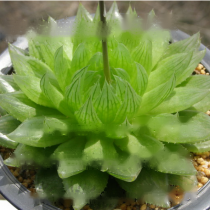
Chinese name: Sakura Crystal
Latin name: Haworthia cooperi var. picturata
Genus: Twelve volumes
Family: Lily Family
Origin: South Africa
1. Morphological characteristics of Sakura crystal
The fleshy leaves of Sakura crystal are arranged in a compact rosette shape, the leaves are thick and plump, green Green, the upper half is transparent or translucent, with dark linear veins, under the conditions of sufficient sunlight, the veins are brown, and the top of the leaves has small whiskers. The flowering period is in spring and autumn. The whole plant is rosette-shaped, expanding outward in layers, the stem in the middle is erect and slender, with a few pubescent hairs and no leaves.
2. Habits of Sakura Crystal
Sakura Crystal likes a sunny environment and is resistant to drought. Avoid scorching sun exposure during high temperature in summer, pay attention to good ventilation, do not need much light, prefer warm, dry, semi-shady environment, pay attention to direct sunlight in high temperature, plants like cool semi-shade environment, drought-resistant but not cold-resistant, no strict requirements for soil , well-drained loam soil.
3. Cultivation of sakura crystals
The difficulty of cultivating sakura crystals is not high. In most cases, the ramets can dig up the young plants next to the mother plant during the growing season. They can survive with or without roots. The cuttings will grow young shoots in the leaf axils at the lower part of the plant, remove them, and carry out cuttings in the culture soil. For leaf cuttings, you can choose strong and substantial cherry crystal succulent leaves, and cut them in a well-drained substrate. Keep the pot soil slightly moist after inserting, and the base of the succulent leaves is easy to take root. FishGrass| Milan Flower| Cornflower|
Myrtle| Sakura| Canna| Bellflower| Thistle|
Hibiscus| Hibiscus| Top Ten Credits|
Calendula | Five-color Plum | Onion Orchid | Morning Glory | | Roselle|
![[Dog Training 5] The training method of pet dog dining etiquette](/static/img/12192/12192_1.jpg)




